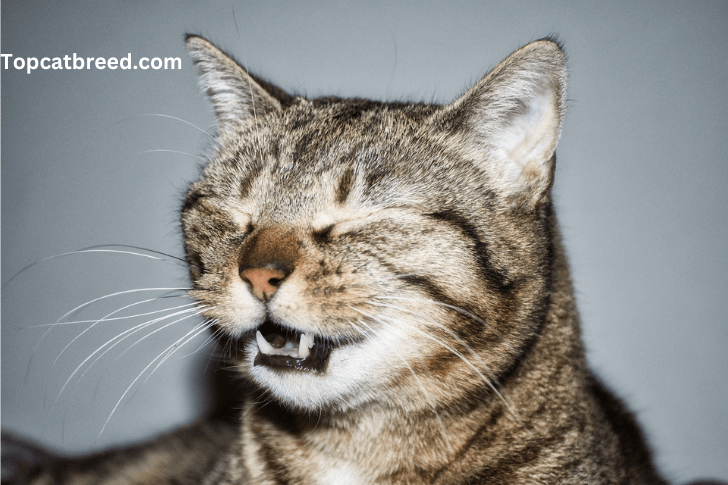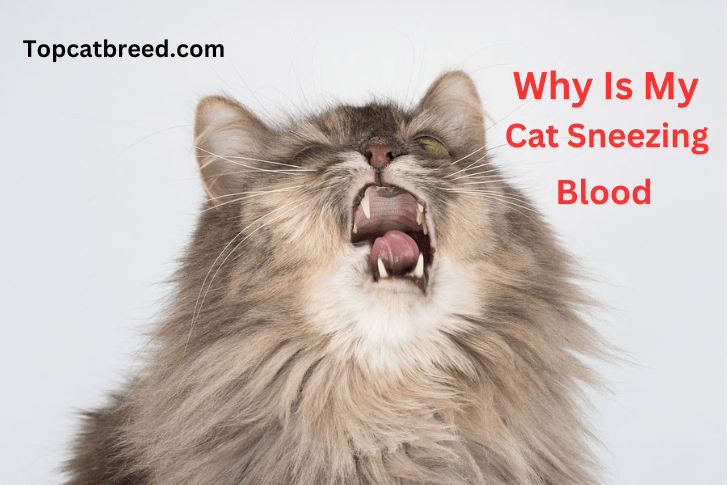“Why is my cat sneezing blood?” is a concerning question that many cat owners may find themselves asking. Cats are known for their cleanliness and generally good health, so when they exhibit symptoms like sneezing blood, it can be alarming. There are several reasons why a cat might experience this unsettling symptom, ranging from common respiratory infections to more serious underlying conditions and further reasons explained below.
Understanding these potential causes is crucial for ensuring the health and well-being of your feline companion. Among the reasons that may lead to a cat sneezing blood are Upper Respiratory Infections, Feline Herpes virus (FHV-1), Feline Calicivirus (FCV), and Nasal Polyps or Tumors. Exploring further into each of these possibilities can help determine the best course of action for diagnosis and treatment.
1. Upper Respiratory Infections
When asking, “Why is my cat sneezing blood?” one of the common culprits is upper respiratory infections (URIs). These infections, similar to the common cold in humans, are caused by viruses or bacteria. They can affect your cat’s nose, throat, and sinuses, causing symptoms such as sneezing, coughing, nasal discharge, and, in extreme cases, bleeding. The most prevalent viruses responsible for URIs in cats are feline herpes virus (FHV-1) and feline Calicivirus (FCV), which we’ll go over in more depth temporarily.
These illnesses are very infectious and can spread quickly, particularly in multi-cat households or crowded settings such as shelters. Keeping your cat’s living place clean, reducing stress, and providing sufficient nourishment and hydration can all help lower the incidence of URIs. If your cat is experiencing symptoms of an upper respiratory infection, such as sneezing blood, it is critical to seek doctor care right once for correct diagnosis and treatment.
2-Feline Herpes Virus (FHV-1)
Feline herpes virus, commonly known as FHV-1, is a highly contagious virus that affects cats worldwide. It is a major cause of upper respiratory infections in felines. Cats infected with FHV-1 may develop sneezing, nasal discharge, fever, lethargy, and, in extreme cases, ocular ulcers or conjunctivitis. The virus can remain latent in the body after the first infection, producing recurring flare-ups during times of stress or sickness.
The virus can cause irritation and inflammation of the nasal passages, resulting in sneezing of blood. While there is no treatment for FHV-1, supportive therapy, such as antiviral drugs and symptom management, can assist your cat’s quality of life while also reducing the frequency and severity of outbreaks. Furthermore, vaccinations against FHV-1 is available and advised for all cats, particularly those with a higher risk of infection.
3-Feline Calicivirus (FCV)
Feline Calicivirus (FCV) is another common viral cause of upper respiratory infections in cats. Like FHV-1, FCV can cause sneezing, nasal discharge, fever, and mouth ulcers. Sneezing blood may be caused by irritation and inflammation of the nasal passages and blood vessels. FCV can also lead to more serious problems including pneumonia and joint inflammation.
Vaccination against FCV is available and is usually included in the basic vaccinations recommended for all cats. Supportive care, such as hydration, correct feeding, and symptomatic therapy, can also help your cat feel better and recover faster. Prompt veterinarian attention is required to diagnose FCV and apply suitable treatment measures.
4. Nasal Polyps or Tumors
Nasal polyps and tumors are less common but potentially serious causes of sneezing blood in cats. polyps nasal are non-cancerous growths that can develop in the nasal passages, obstructing airflow and causing irritation and inflammation. Tumors, on the other hand, can be benign or malignant and can develop in the nasal cavity or surrounding tissues. These growths can cause symptoms such as frequent sneezing, nasal discharge (which may contain blood), trouble breathing, face swelling, and vocalization abnormalities.
Imaging investigations, such as X-rays or CT scans, are often used to make a diagnosis, followed by a biopsy to confirm the growth. Depending on the nature and size of the tumor, treatment options include surgical removal, radiation therapy, or chemotherapy. Early identification and treatments are critical to improve the prognosis and quality of life for cats with nasal polyps or tumors.
5-Allergies
Allergies can affect cats just as they do humans, leading to various symptoms, including sneezing blood. Cats can be allergic to a variety of things, including pollen, dust mites, mold, certain foods, and even flea bites. When an allergic reaction develops, the immune system overreacts to these innocuous molecules, producing inflammation in the nasal passages and perhaps rupturing blood vessels, resulting in sneezing blood.
Itching, skin rashes, coughing, and watery eyes are some frequent symptoms of cat allergies. The basic method to controlling allergies in cats is to identify the allergen and avoid it wherever feasible. To relieve discomfort and minimize inflammation, your veterinarian may offer antihistamines or corticosteroids. In extreme circumstances, allergy testing and immunotherapy (allergy injections) may be required to desensitize your cat’s immune system to the allergen.
6. Trauma or Injury
Trauma or injury to the head or face can cause nasal bleeding in cats, leading to symptoms like sneezing blood. It is frequently caused by falls, auto accidents, animal conflicts, and mishaps while playing. Bleeding from injuries to the nasal passages or adjacent tissues might appear as blood-tinged nasal discharge or bloody sneezes.
Trauma can also result in fractures or damage to the fragile skull bones, which can create more issues. Contact a veterinarian right once if you think your cat may have been harmed. In addition to doing a comprehensive physical examination, your veterinarian could advise imaging tests like CT or X-rays to determine the extent of the damage. Depending on how serious the damage is, treatment options may include wound care, pain control, and, in extreme circumstances, surgery.
7. Foreign Objects in Nasal Passages
Cats are naturally curious creatures and may inadvertently inhale or sniff foreign objects, such as grass blades, seeds, or small toys, into their nasal passages. These foreign objects have the potential to lodge in the nasal cavity and irritate, inflame, or even harm the sensitive nasal tissues. Your cat could therefore exhibit signs including bloody sneezes, nasal discharge, and breathing difficulties.
8. Dental Problems
Dental problems can also contribute to sneezing blood in cats, albeit less commonly than respiratory issues or trauma. Periodontal disease, tooth decay, and oral tumors are dental conditions that can induce inflammation and infection in the mouth, which can result in bloody nasal discharge. Other symptoms of dental issues in cats might include foul breath, drooling, unwillingness to feed, and mouth-pawing. In cats, dental problems may be avoided with regular dental care, which includes brushing their teeth and getting expert cleanings.
Your veterinarian may suggest thoroughly examining your cat’s teeth while sedated to determine the severity of the condition and perform any necessary procedures, such as periodontal therapy or extractions. Timely treatment of dental issues can enhance your cat’s general well-being and avoid disadvantages like bleeding when they sneeze.
Treatment Options when my cat sneezing blood

When your cat is sneezing blood, it’s essential to seek prompt veterinary care to determine the underlying cause and initiate appropriate treatment. Here are three common treatment options your veterinarian may recommend:
- Medication for Infections: If your cat’s sneezing blood is due to an upper respiratory infection, such as feline herpesvirus (FHV-1) or feline Calicivirus (FCV), your veterinarian may prescribe antiviral medications or antibiotics. These medications help combat the infection, reduce inflammation in the nasal passages, and alleviate symptoms such as sneezing and nasal discharge.
- Surgical Intervention: In cases where nasal polyps or tumors are causing your cat’s symptoms, surgical removal may be necessary. Surgery aims to remove the obstruction, alleviate nasal inflammation, and restore normal breathing. Depending on the size and location of the growth, your veterinarian may perform minimally invasive procedures or more extensive surgery to address the issue effectively.
- Supportive Care: Alongside specific treatments for the underlying cause, your veterinarian may recommend supportive care measures to help your cat recover. This may include providing a comfortable and stress-free environment, ensuring proper hydration and nutrition, and administering medications to relieve discomfort or pain.
Preventive Measures when cat sneezing blood
While treating your cat’s sneezing blood is essential, taking preventive measures can help reduce the risk of recurrence and promote your cat’s overall health and well-being. Here are three preventive measures to consider:
- Vaccination: Keeping your cat up-to-date on vaccinations is crucial for preventing infectious diseases that can lead to sneezing blood. Ensure your cat receives core vaccines, including those for feline herpes virus (FHV-1) and feline Calicivirus (FCV), as recommended by your veterinarian. Vaccination helps protect your cat from potential infections and reduces the severity of symptoms if exposure occurs.
- Environmental Management: Create a clean and safe environment for your cat by minimizing potential allergens and hazards. Regularly clean your cat’s living area to reduce dust, mold, and other irritants that could trigger respiratory issues. Keep toxic plants, chemicals, and small objects out of your cat’s reach to prevent accidental ingestion or injury.
- Regular Veterinary Check-ups: Schedule regular check-ups with your veterinarian to monitor your cat’s health and catch any potential issues early. Routine examinations allow your veterinarian to assess your cat’s overall well-being, provide preventive care, and address any concerns or changes in health promptly. Open communication with your veterinarian ensures that your cat receives the best possible care and preventive measures tailored to their individual needs.
By implementing these treatment options and preventive measures, you can help manage your cat’s sneezing blood effectively and minimize the risk of future episodes. Remember to consult your veterinarian for personalized recommendations and guidance based on your cat’s specific health needs and circumstances.
Conclusion
In conclusion, understanding “why is my cat sneezing blood” is crucial for providing timely and effective care for our feline companions. By exploring the various potential causes, from infections to dental issues, and discussing treatment options and preventive measures, we empower ourselves to advocate for our cat’s health. Prompt veterinary attention, alongside preventive measures like vaccinations and environmental management, can significantly improve our cat’s well-being and reduce the likelihood of future episodes. Remember, staying informed and proactive is key to ensuring a happy and healthy life for our beloved cats.

